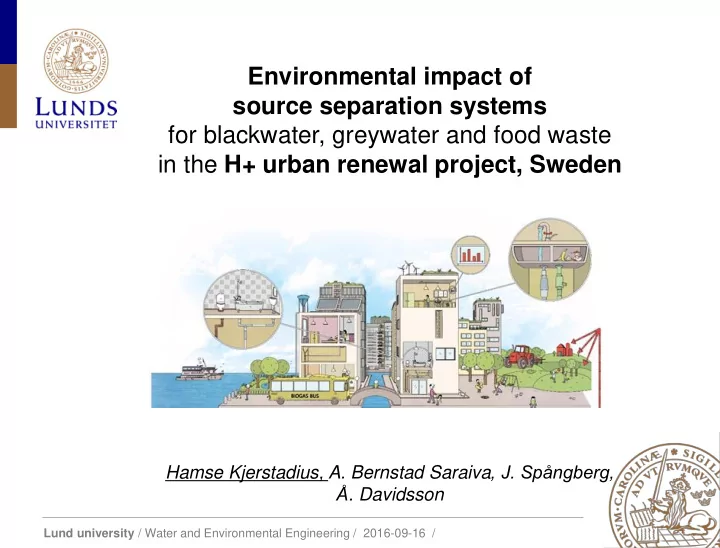

Environmental impact of source separation systems for blackwater, greywater and food waste in the H+ urban renewal project, Sweden Hamse Kjerstadius, A. Bernstad Saraiva , J. Spångberg, Å . Davidsson Lund university / Water and Environmental Engineering / 2016-09-16 /
Background Background: • The city of Helsingborg (Sweden) will start building source separation systems for 1 200 people in 2017 • Main reason is increased biogas production but nutrient recovery was also important (Swedish EPA suggests national targets for nutrient recovery from wastewater) 40% of the phosphorus and 10% of the nitrogen So…. • How much nutrients can you recover AND what is the environmental impact of this for Swedish conditions? (clean electricity and heat production) Lund university / Water and Environmental Engineering / 2016-09-16 /
Background Method Method: • Life cycle assessment with system boundary to include entire management chain. Lund university / Water and Environmental Engineering / 2016-09-16 /
Background Method DESCRIPTION OF SYSTEMS - Conventional system - Source separation system Lund university / Water and Environmental Engineering / 2016-09-16 /
Background Method Conventional system 100% FW Food waste plant WWTP BW+GW Biogas upgrading & use 75% 25% Soil storage and Soil improver Ocean recipient agriculture Lund university / Water and Environmental Engineering / 2016-09-16 /
Background Method Source separation system Nutrient FW recovery Biogas upgrading & use BW GW WWTP 75% 25% sludge 100% struvite and amm. sulphate Soil storage and Soil improver Ocean recipient agriculture Lund university / Water and Environmental Engineering / 2016-09-16 /
Background Method Method: • Life cycle assessment with system boundary to include entire management chain. Replaced mineral fertilizer Replaced vehicle fuel (diesel) Lund university / Water and Environmental Engineering / 2016-09-16 /
Background Method Indata: • Process data from litterature (EcoInvent database v.3) , real plants or suppliers. • Mass balances for organic material, phosphours and nitrogen. 𝐉𝐧𝐪𝐛𝐝𝐮 𝐝𝐛𝐮𝐟𝐡𝐩𝐬𝐣𝐟𝐭 Return of Return of Climate nitrogen to phosphorus to change farmland farmland Kg CO 2 eq kg N kg P 𝐆𝐯𝐨𝐝𝐮𝐣𝐩𝐨𝐛𝐦 𝐕𝐨𝐣𝐮 = 𝐍𝐛𝐨𝐛𝐡𝐟𝐧𝐟𝐨𝐮 𝐩𝐠 𝟐 𝐝𝐛𝐪𝐣𝐮𝐛 𝐦𝐩𝐛𝐞 𝐩𝐠 𝐆𝐗, 𝐂𝐗 𝐛𝐨𝐞 𝐇𝐗 𝐳𝐟𝐛𝐬 Lund university / Water and Environmental Engineering / 2016-09-16 /
Background Method Results RESULTS Lund university / Water and Environmental Engineering / 2016-09-16 /
Background Method Results Potential for nutrient recovery to farmland Nitrogen Phosphorus • Source separation system increases nutrient return due to usage of struvite and ammonium stripper. Lund university / Water and Environmental Engineering / 2016-09-16 /
Background Method Results Impact on climate change • Source separation systems decreases climate impact due to: • increased biogas production (replace diesel as vehicle fuel) • less N 2 O-emissions from activated sludge (strong greenhouse gas) • Replaced nitrogen mineral fertilizer (nitrogen fixation is energy demanding) • Less emissions from sludge storage (methane and N 2 O) Lund university / Water and Environmental Engineering / 2016-09-16 /
Background Method Results Conclusions CONCLUSIONS Lund university / Water and Environmental Engineering / 2016-09-16 /
Background Method Results Conclusions Conclusions: • Source separation systems have a high potential for recovery of nutrients. • Source separation systems decreases climate impact (with 21-56 kg CO 2 capita -1 year -1 ). Benefit is increased with ” dirtier ” european electricity mix. Lund university / Water and Environmental Engineering / 2016-09-16 /
Background Method Results Conclusions If you want to reduce climate impact: • Maximize biogas production and replacement of mineral fertilizer. • Decrease emissions of nitrous oxide (N 2 O) from your activated sludge plants. • Decrease emissions of methane and nitrous oxide from sludge storage (dewater and cover the sludge storage). Lund university / Water and Environmental Engineering / 2016-09-16 /
Thank you for your attention hamse.kjerstadius@chemeng.lth.se HAMSE KJERSTADIUS WATER AND ENVIRONMENTAL ENGINEERING, DEP. CHEMICAL ENGINEERING Lund university / Water and Environmental Engineering / 2016-09-16 /
Recommend
More recommend